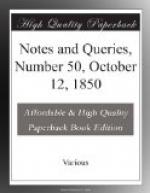QUEEN ELIZABETH AND SIR HENRY NEVILL.
Many years ago I copied the following note from a volume of Berkshire pedigrees in the British Museum, my reference to which is unluckily lost.
“Queen Elizabeth, in her first progress at Maidenhithe Bridge, being mett by all the Nobility, Kn’ts, and Esquires of Berks, they kneeling on both sides of her way, shee alighted at the bridge foot, and walked on foote through the midst, and coming just agaynst Sir Henry Nevill of Billingbear, made a stay, and leyd her glove on his head, saying, ’I am glad to see thee, Brother Henry.’ Hee, not pleased with the expression, swore she would make the court believe hee was a bastard, at which shee laughed, and passed on.”
The masquing scene in Henry VIII., as described by Holinshed, perhaps furnishes a clue to the Queen’s pleasantry, though Shakspeare has omitted the particular incident relating to Sir Henry Nevill. The old chronicler, after giving an account of Wolsey’s banquet, and the entrance of a noble troop of strangers in masks, amongst whom he suspected that the king made one, proceeds as follows:—
“Then the Lord Chamberlain said to the Cardinal, Sir, they confesse that among them there is such a noble personage whom, if your Grace can appointe out ’from the rest, he is content to disclose himself and to accept your place.’ Whereupon the Cardinal, taking good advisement among them, at the last quoth he, ’Me seemeth the gentleman in the black beard should be even he.’ And with that he arose out of his chaire and offered the same to the gentleman in the black beard, with his cap in his hand. The person to whom he offered the chaire was Sir Edward Nevill, a comelie knight, that much more resembled the king’s person in that mask than anie other. The King perceiving the Cardinal so deceived, could not forbear laughing, and pulled down his visor and Maister Nevill’s too.”
Sir Edward Nevill of Aldington, in Kent, was the second surviving son of George Nevill, Lord Abergavenny, and the father of Sir Henry Nevill above mentioned, who laid the foundation-stone and built the body and one wing of Billingbear House, which still belongs to his descendant. Sir Edward Nevill was beheaded for high treason in 1538, his likeness to Henry VIII. not saving him from the fate which befell so many of that king’s unhappy favourites.
BRATHBROOKE.
Audley End.
* * * * *
MINOR NOTES.
Whales.—Tychsen thinks the stories of whales mistaken for islands originated in the perplexities of inexperienced sailors when first venturing from {308} the Mediterranean into a sea exposed to the tides. I think Dr. Whewell mentions that in particular situations the turn of the current occurs at a sufficient interval from the time of high or low water to perplex even the most experienced sailors.
F.Q.




